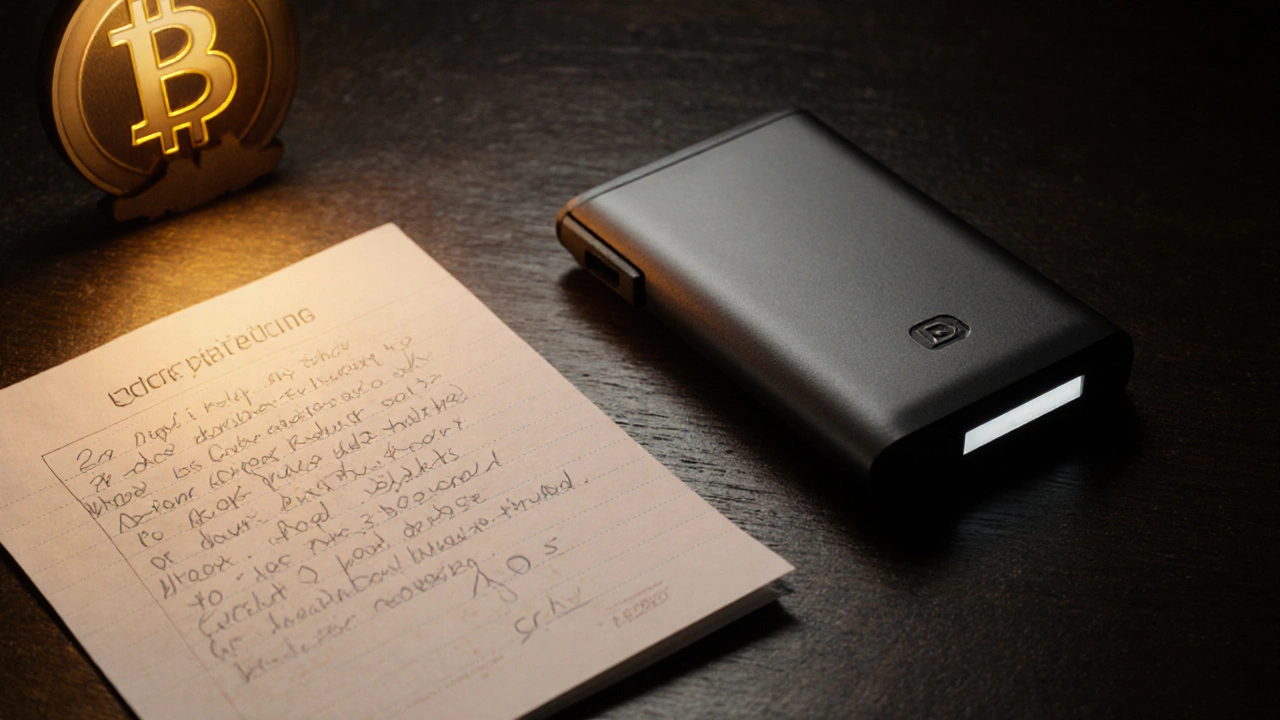Best Crypto Wallet for Bitcoin in 2025
If you own Bitcoin, your wallet isn’t just a digital folder-it’s your bank, your vault, and your only line of defense against theft. Losing access to your wallet means losing your Bitcoin forever. No customer service, no password reset, no second chances. That’s why choosing the best crypto wallet for Bitcoin isn’t about features or looks-it’s about control, safety, and simplicity.
What Makes a Bitcoin Wallet Good?
A good Bitcoin wallet does three things: keeps your private keys safe, lets you send and receive Bitcoin easily, and doesn’t trick you into giving up control. Too many people think a wallet is just an app that shows their balance. It’s not. The wallet is the tool that holds the keys to your coins. If someone else controls those keys, you don’t own your Bitcoin.There are two main types of wallets: custodial and non-custodial. Custodial wallets (like Coinbase or Binance) hold your keys for you. They’re easy to use, but you’re trusting a company with your life savings. If they get hacked, go bankrupt, or change their rules, your Bitcoin could vanish. Non-custodial wallets put you in charge. You hold the keys. You’re responsible. That’s why they’re the only real choice for serious Bitcoin holders.
Hardware Wallets: The Gold Standard
For most people, the best crypto wallet for Bitcoin is a hardware wallet. These are small physical devices-like a USB drive-that store your private keys offline. No internet connection means no hackers can reach them. Even if your computer gets infected with malware, your Bitcoin stays safe.Two brands dominate the market: Ledger and Trezor. Both have been around since 2014 and have proven track records. Ledger Nano S Plus and Ledger Nano X are the most popular. The Nano X adds Bluetooth, so you can manage your wallet from your phone without plugging it in. The Nano S Plus is cheaper and still perfectly secure. Both support Bitcoin, Ethereum, and over 5,000 other tokens.
Trezor Model T is the premium option. It has a touchscreen, so you can confirm transactions right on the device instead of looking at a computer screen. That reduces the risk of phishing attacks. It also supports more advanced features like multisig and coinjoin, which are useful if you’re doing serious privacy work.
Neither device has ever been hacked in a way that stole user funds. That’s not luck-it’s design. Both use open-source software, so security experts worldwide can check the code. They also require a 24-word recovery phrase. Write it down on paper. Store it in a fireproof safe. Never type it into a computer. If you lose the device, you restore your wallet using that phrase on a new one.
Software Wallets: For Everyday Use
Hardware wallets are ideal for storing large amounts of Bitcoin. But if you’re sending small amounts daily-like paying for coffee or tipping on a crypto platform-you don’t want to plug in a device every time. That’s where software wallets come in.Electrum is the most trusted Bitcoin-only software wallet. It’s been around since 2011, is open-source, and runs on Windows, Mac, Linux, and Android. It doesn’t store your keys online. Instead, it connects to public Bitcoin servers to check your balance, but your private keys stay on your device. You can even run your own Bitcoin node with Electrum for maximum privacy.
Blue Wallet is another solid option, especially for mobile users. It’s clean, fast, and supports Lightning Network payments, which let you send Bitcoin instantly for pennies. It also lets you create multiple wallets inside one app-use one for savings, one for spending. You can even back it up to iCloud or Google Drive, but only if you encrypt the backup with a password you remember.
Never use a wallet that asks for your recovery phrase to sign up. That’s a scam. Legit wallets never ask for it. If they do, close the app. Walk away.

What to Avoid
There are hundreds of Bitcoin wallets out there. Most are garbage. Here’s what to skip:- Wallets from unknown developers with no public code
- Mobile wallets that don’t let you export your private keys
- Web wallets that require you to log in with email
- Any wallet that promises ‘auto-staking’ or ‘high interest’ on Bitcoin
- Wallets that are only available on iOS and not on Android (or vice versa)-they’re often trying to lock you in
One common trap: wallets that say they’re ‘Bitcoin-only’ but require you to create an account. That’s not a wallet-it’s an exchange pretending to be a wallet. If you have to register, you don’t own your keys.
How to Set Up Your Wallet Right
Buying the right wallet is only half the battle. Setup matters just as much.- Unbox the device on a clean computer-no malware, no public Wi-Fi.
- Follow the instructions to generate your 24-word recovery phrase.
- Write it down by hand on acid-free paper. Don’t type it. Don’t screenshot it.
- Store the paper in a secure place-like a safe or safety deposit box.
- Test the recovery phrase by wiping the device and restoring from backup.
- Only send small amounts at first to confirm everything works.
Never store your recovery phrase on your phone, cloud drive, or email. Hackers scan those places. One breach and your Bitcoin is gone.

Backup Strategies That Actually Work
A single backup isn’t enough. You need redundancy without risk.Use the Shamir Secret Sharing method. Some wallets, like Ledger and Trezor, let you split your 24-word phrase into 3 or 5 parts. You need any 2 of them to restore your wallet. Store one part at home, one with a trusted family member, one in a bank vault. Even if one is lost or destroyed, you’re still safe.
Another option: metal seed plates. Companies like Cryptosteel make titanium or stainless steel plates you can etch your recovery phrase onto. They survive fire, water, and time. Keep one at home and one elsewhere. It’s cheap insurance.
What About Mobile Wallets Like Trust Wallet or MetaMask?
Trust Wallet and MetaMask are great for Ethereum and altcoins. But for Bitcoin? They’re risky. Both are custodial in practice-they rely on third-party servers to broadcast transactions. They also don’t support advanced Bitcoin features like Taproot or Lightning out of the box. If you’re holding more than $500 in Bitcoin, don’t use them as your main wallet.They’re fine for small, temporary amounts-like buying a coffee with Bitcoin. But not for storing your life savings.
Final Recommendation
If you’re holding Bitcoin long-term, buy a Ledger Nano S Plus or Trezor Model T. Spend $50-$100 now to protect thousands-or millions-later. Use Electrum or Blue Wallet for daily spending. Never mix the two. Keep your savings cold, your spending hot.Bitcoin’s value isn’t in the price chart. It’s in your ability to control it without permission. The best crypto wallet for Bitcoin is the one that lets you do exactly that-with no compromises.
Can I use the same Bitcoin wallet on multiple devices?
Yes, but only if you use your recovery phrase to restore the wallet on each device. Never copy private keys between devices. Always restore from the 24-word phrase on a clean, secure machine. Using the same wallet on multiple phones or computers increases your risk of exposure.
Is a hardware wallet really safer than a software wallet?
Yes, because hardware wallets store private keys offline, away from internet-connected devices where malware, phishing, and remote attacks happen. Software wallets run on phones or computers that are always connected. Even the most secure software wallet can be compromised if your device is infected. Hardware wallets add a physical layer of protection that software can’t match.
What happens if I lose my hardware wallet?
If you lose your hardware wallet but still have your 24-word recovery phrase, you can restore your Bitcoin on any compatible wallet-new Ledger, Trezor, or even Electrum. Your Bitcoin isn’t tied to the device. It’s tied to the keys. The device is just a tool to access them. Without the phrase, your Bitcoin is gone forever.
Should I use a wallet provided by my exchange?
Only for short-term trading. Exchanges like Binance or Coinbase control your private keys. That means they can freeze your account, delay withdrawals, or lose your funds if they get hacked. In 2022, FTX collapsed and users lost over $8 billion. If you’re holding Bitcoin for more than a few days, move it to a wallet you control.
Are free Bitcoin wallets safe?
Most aren’t. Free wallets often monetize by selling your data, injecting ads, or routing your transactions through third-party servers that can track or delay them. Some even steal recovery phrases during setup. Stick to well-known, open-source wallets with years of public audits. If it’s free and you don’t know who made it, assume it’s dangerous.






12 Comments
Mark Brantner
November 7 2025bro i just use coinbase and it’s fine??? why are we all acting like we’re guarding the holy grail???
saravana kumar
November 9 2025This entire post is just Ledger affiliate marketing disguised as wisdom. You think people don’t know hardware wallets are overpriced paperweights? I’ve seen more secure wallets on Android apps with 100k downloads and zero audits.
Tamil selvan
November 9 2025I appreciate the thoroughness of this guide, and I must emphasize that the distinction between custodial and non-custodial wallets is not merely technical-it is philosophical. Ownership of Bitcoin is sovereignty, and surrendering private keys, even for convenience, is a quiet erosion of autonomy. Please, for your own peace of mind, invest in a hardware wallet.
chioma okwara
November 11 2025you wrote 'you’re trusting a company with your life savings' but you forgot to put a comma after 'company'... also 'bitcoin' should be capitalized every time. this post is a mess.
Deepak Sungra
November 13 2025i used a free wallet once and lost 0.3 btc. now i cry every night. my dog left me. my cat judges me. i dont trust anyone anymore. even my toaster looks at me funny.
Tasha Hernandez
November 13 2025Oh sweet summer child. You think Ledger is safe? They had that firmware backdoor in 2021. The FBI found it. They just didn’t tell you. Your ‘secure’ device is just a fancy USB stick with a government backdoor and a 24-word suicide note you wrote on a napkin.
Jim Sonntag
November 14 2025hardware wallets are cool i guess but have you tried just memorizing your seed phrase and using a piece of paper in a locked drawer no device needed just you and your brain and the ghost of your future self who will forget it in 5 years
Samar Omar
November 14 2025I find it profoundly unsettling that anyone would consider using a software wallet for anything beyond microtransactions. The very notion is a betrayal of Bitcoin’s foundational ethos. To entrust your wealth to an operating system vulnerable to kernel exploits, phishing overlays, and Android malware is akin to storing the Mona Lisa in a cardboard box outside a bodega. I weep for the future.
John Fox
November 16 2025i use electrum on a raspberry pi with tor and a usb drive its fine
amber hopman
November 17 2025I actually love how this post doesn’t just list wallets but explains why control matters. I used to think hardware wallets were overkill until I read about the Trezor phishing attack last year. Now I have two Nano S Pluses-one at home, one with my sister. It’s not paranoia, it’s planning.
Anuj Kumar
November 17 2025ledger is a fbi front. they gave the keys to the feds in 2020. your bitcoin is already gone. you just dont know it yet.
Kate Tran
November 18 2025I just bought a Ledger last week and honestly? The setup was way easier than I thought. I wrote my phrase on three pieces of paper, put one in a safe, one in a waterproof case with my grandma’s jewelry, and one with my lawyer. No cloud. No phone. Just paper and peace of mind.